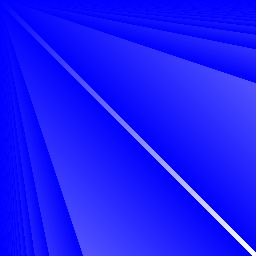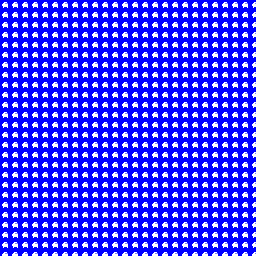Created
April 2, 2012 02:40
-
-
Save tetsuok/2280162 to your computer and use it in GitHub Desktop.
An answer of the exercise: Slices on a tour of Go
This file contains bidirectional Unicode text that may be interpreted or compiled differently than what appears below. To review, open the file in an editor that reveals hidden Unicode characters.
Learn more about bidirectional Unicode characters
| package main | |
| import "code.google.com/p/go-tour/pic" | |
| func Pic(dx, dy int) [][]uint8 { | |
| // Allocate two-dimensioanl array. | |
| a := make([][]uint8, dy) | |
| for i := 0; i < dy; i++ { | |
| a[i] = make([]uint8, dx) | |
| } | |
| // Do something. | |
| for i := 0; i < dy; i++ { | |
| for j := 0; j < dx; j++ { | |
| switch { | |
| case j % 15 == 0: | |
| a[i][j] = 240 | |
| case j % 3 == 0: | |
| a[i][j] = 120 | |
| case j % 5 == 0: | |
| a[i][j] = 150 | |
| default: | |
| a[i][j] = 100 | |
| } | |
| } | |
| } | |
| return a | |
| } | |
| func main() { | |
| pic.Show(Pic) | |
| } |
bryceleue
commented
Sep 16, 2023

Very suspicious pattern
package main
import "golang.org/x/tour/pic"
const (
VAL_MAX uint8 = 255
AMOG_DX uint8 = 10
AMOG_DY uint8 = 10
)
// ඞ
var AMOGUS = [AMOG_DY][AMOG_DX]uint8{
{0, 0, 0, 0, 0, 0, 0, 0, 0, 0},
{0, 0, 0, 0, 0, 0, 0, 0, 0, 0},
{0, 0, 0, 0, 2, 2, 2, 0, 0, 0},
{0, 0, 0, 2, 2, 1, 1, 1, 0, 0},
{0, 0, 2, 2, 2, 2, 2, 2, 0, 0},
{0, 0, 2, 2, 2, 2, 2, 2, 0, 0},
{0, 0, 0, 2, 2, 2, 2, 2, 0, 0},
{0, 0, 0, 2, 0, 0, 0, 2, 0, 0},
{0, 0, 0, 0, 0, 0, 0, 0, 0, 0},
{0, 0, 0, 0, 0, 0, 0, 0, 0, 0},
}
func Shader(x, y int) uint8 {
x_u := uint8(x) % AMOG_DX
y_u := uint8(y) % AMOG_DY
return AMOGUS[y_u][x_u]*(VAL_MAX>>1) + 1
}
func Pic(dx, dy int) [][]uint8 {
buf := make([][]uint8, dy)
for y := range buf {
column := make([]uint8, dx)
for x := range column {
column[x] = Shader(x, y)
}
buf[y] = column
}
return buf
}
func main() {
pic.Show(Pic)
}package main
import "golang.org/x/tour/pic"
// import "fmt"
func pointValue1(x, y int) uint8 {
return uint8((x + y) / 2)
}
func pointValue2(x, y int) uint8 {
return uint8(x * y)
}
func pointValue3(x, y int) uint8 {
return uint8(x ^ y)
}
func Pic(dx, dy int) [][]uint8 {
// initialize slice rows with dy length
var matrix [][]uint8
// initialize the i'th element of rows with dx length slice
for i := 0; i < dy; i ++ {
// var array_rows [dx]uint8
var array_rows []uint8
// update the value of each point
for j := 0; j < dx; j ++ {
// array_rows[j] = pointValue1(i, j)
array_rows = append(array_rows, pointValue3(i, j))
}
// matrix = append(matrix, array_rows[0:])
matrix = append(matrix, array_rows)
}
// fmt.Println(matrix)
return matrix
}
func main() {
pic.Show(Pic)
}package main
import (
"golang.org/x/tour/pic"
)
func Pic(dx, dy int) [][]uint8 {
result := make([][]uint8, dy)
for y := range result {
result[y] = make([]uint8, dx)
for x := range result[y] {
result[y][x] = uint8((x + y) / 2)
}
}
return result
}
func main() {
pic.Show(Pic)
}
Sign up for free
to join this conversation on GitHub.
Already have an account?
Sign in to comment




